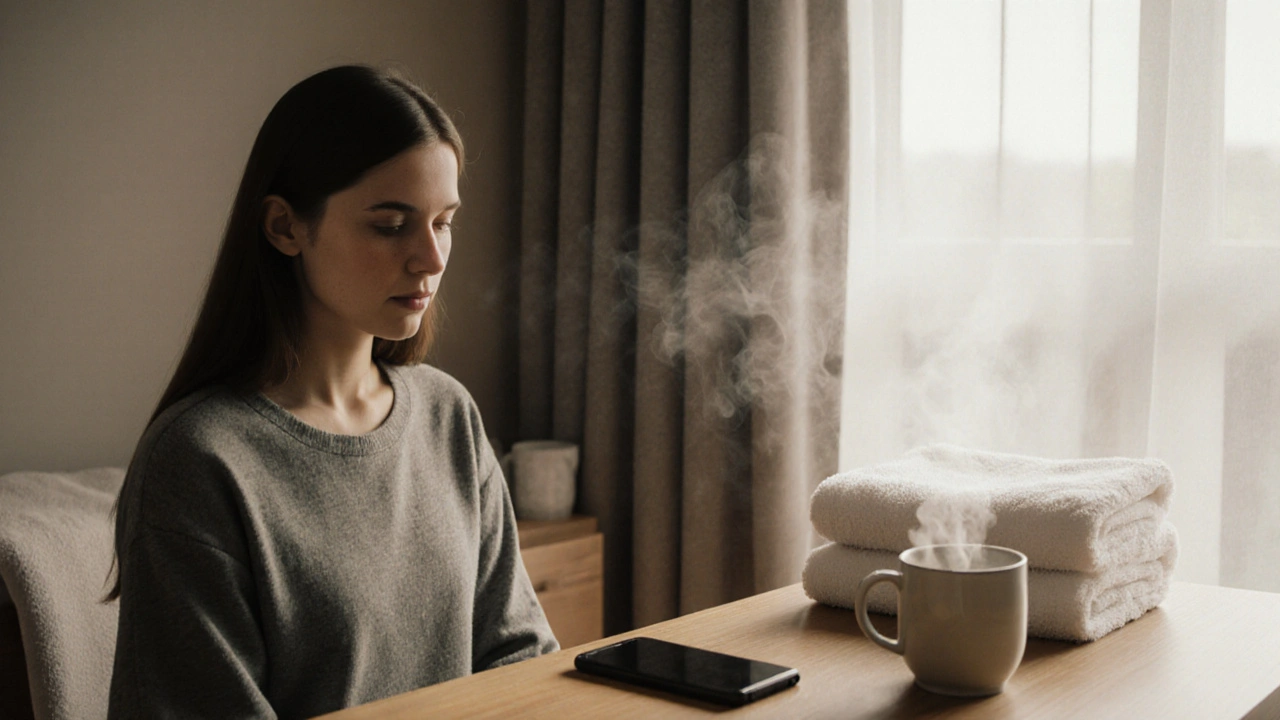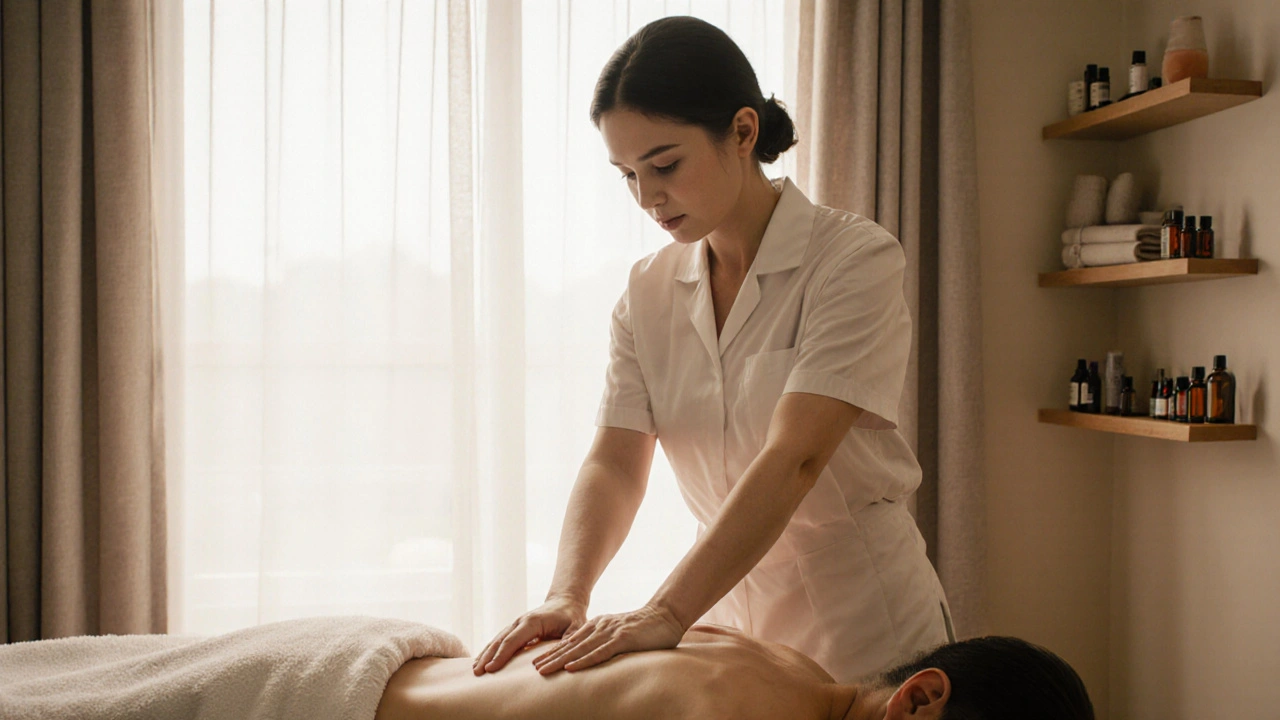Explore how Thai massage helps you fall asleep faster, improves sleep quality, and tackles insomnia. Practical tips, session insights, and answers to FAQs included.

- Created by: Liam Redgate
- Completed on: 21 Apr 2025
- Categories: Massage Therapy
Ever booked a massage and walked out thinking, “That was okay, but was there more I could’ve done to make the most of it?” You’re definitely not alone. Whether you’re trying to shake off a stiff neck, recover from an intense workout, or just zone out for an hour, a great massage can work wonders—but only if you know how to approach it.
If you’ve never seen a massage therapist before, it can be tough to know what to expect. Spoiler: it’s not weird to ask questions, share your preferences, or even get super specific about pressure points that need a little extra love. It's actually the best way to make sure you walk out feeling looser, lighter, and like you got exactly what you needed.
Here’s the thing—prepping for a massage isn’t rocket science, but a few smart moves before and during your appointment can seriously level up your results. Little details—from hydrating to mentioning old injuries—add up big time. Most people don’t realize how much control they have over their own experience.
Curious about different massage styles, how to actually find someone legit in your area, or what to do if you get nervous in a new setting? Stick around. You’ll get straight answers, practical tips, and some inside tricks therapists usually wish clients knew before their first visit. Ready to feel better already?
- Key Takeaways
- Quick Answer: Getting the Most from Massage
- What Does a Massage Therapist Do?
- Why Booking the Right Massage Matters
- Finding and Booking the Best Therapist Near You
- Tips for Getting the Perfect Session
Key Takeaways
If you want to really get the most out of your session with a massage therapist, a bit of planning goes a long way. Don’t just show up and hope for the best—knowing a few key things makes the difference between a decent massage and one you can’t stop talking about.
- Be clear with your massage therapist about what you need. Tell them if it’s stress, muscle pain, or just needing to relax. It’s not awkward—they actually want to know.
- Try different massage types—like Swedish, deep tissue, or sports—because each style works for different goals. Asking about these shows you’re interested in customizing your session.
- It pays off to show up hydrated and avoid a heavy meal or caffeine before your appointment. Your body will thank you later, and your therapist can work with your muscles more easily.
- Feel free to give feedback during your massage—don’t be shy if it’s too much or too little pressure. A good massage therapist actually expects some real-time communication.
- Know the average prices and how booking works, whether that’s through an app, phone call, or website. Most places offer discounts if you book multiple sessions up front.
- Always check your massage therapist’s certifications and licenses. In most states, a legit therapist must list their license number and qualifications, usually on their profile or booking page.
| Fact | Details |
|---|---|
| Average Massage Length | Usually 60 minutes, but options range from 30 to 120 minutes |
| Certified Therapists | Look for therapists with state certification and membership in a recognized association |
| Hydration Impact | Clients who drink enough water before a session report less soreness afterward |
Remember, the best way to maximize your massage is by being honest, open, and willing to speak up. Little things like communication and prep make your therapist’s job easier and lead to way better results for you.
Quick Answer: Getting the Most from Massage
If you just want to know how to really get the most out of your next visit to a massage therapist, here are the key moves: communicate clearly, show up on time, and take care of yourself after the session. That’s the nutshell version, but let’s dig a bit deeper.
First, always be upfront about what you want and where you’re feeling pain or tension. Don’t be shy—massage therapists hear it all the time. The more honest you are, the better they can tailor the session to your needs. If you’re not sure what type of massage suits you—like Swedish for relaxation or deep tissue for knots—just ask. A good therapist will help you decide.
According to the American Massage Therapy Association, “Your feedback during a session is vital. We want you to speak up about comfort, pressure, and any concerns.”
Your feedback during a session is vital. We want you to speak up about comfort, pressure, and any concerns. — American Massage Therapy Association
It’s also a smart move to drink water before and after your session. Staying hydrated helps your muscles recover better. Avoid heavy meals about an hour before—no one wants to get a massage on a full stomach, trust me.
Lots of people want to know if regular massages pay off. The Cleveland Clinic reports that weekly or bi-weekly massages can help reduce chronic pain, boost circulation, and ease stress faster than a once-in-a-blue-moon treat.
| Massage Frequency | Reported Benefits (in studies) |
|---|---|
| Once per month | Mild stress relief |
| Every 2 weeks | Better pain management, more flexibility |
| Weekly | Significant reduction in anxiety and muscle tension |
Bottom line: a little prep work and clear communication can turn a “meh” session into something game-changing. Your comfort and results are mostly in your hands—just speak up and let your therapist know what works for you. That’s how you cash in on the full benefits of a massage therapist session.
What Does a Massage Therapist Do?
A massage therapist isn’t just someone who rubs your back for an hour—they’re trained professionals who know how to work with your muscles, ease pain, and even help your mood. Most of them have spent months, if not years, studying anatomy, physiology, and all kinds of hands-on techniques.
In a basic sense, massage therapists use their hands (sometimes elbows or even forearms) to knead, stretch, and press muscles all over your body. The goal? Get rid of tightness, boost your blood flow, melt away stress, and help you feel more balanced overall. They're not just guessing which muscles to target—they're trained to spot knots, tension, or swelling that you might not even realize are there.
Here’s what a typical massage therapist does during a session:
- Asks about your health and what you’re hoping to get out of the massage. Injuries, stress, sore spots—it all matters.
- Gives you time to get comfortable, then checks that the pressure and style feel good for you. You can always ask for more or less pressure any time.
- Uses specific strokes and techniques, which can change depending on what you need—relaxation, pain relief, recovery, or sports prep.
- Focuses on your unique needs—maybe more time on your lower back, or working out that chronic tension in your neck or shoulders.
- Offers tips for aftercare, like stretching, hydrating, or coming back for another session if you need to stay on top of an issue.
There’s a science to what they do. In fact, studies have shown that just one session of Swedish massage—one of the most common types—can lower levels of the stress hormone cortisol. Another stat worth knowing: a survey by the American Massage Therapy Association found around 35% of people who got a massage did so because of medical or therapeutic reasons, not just “treat yourself” days.
Some massage therapists even specialize. You’ll find pros trained for deep tissue, prenatal massage for moms-to-be, sports recovery for athletes, or lymphatic drainage if you’re dealing with swelling. Some work in clinics alongside doctors or physical therapists, while others are all about relaxation at spas.
Bottom line, their real job is to listen, adapt, and give you the best shot at walking out feeling way better than you did when you walked in. Remember, communication is everything—don’t be shy about sharing what’s going on with your body. That’s how a good massage therapist can really help.

Why Booking the Right Massage Matters
Booking the right massage therapist isn’t just about finding someone with an available slot next week. Getting matched with the right pro makes all the difference in how you feel after your session. Every therapist brings a different skill set—some might be wizards at Swedish massage for those who want to chill out, while others specialize in deep tissue work for tight muscles or sports injuries.
Let’s be real: if you’re after big results, you need to connect with someone who understands your goals. A good therapist will always ask about your comfort level, aches and pains, and even stuff like allergies or skin sensitivities. That one chat before your session sets the tone—and keeps things safe and enjoyable.
Therapists train for hundreds of hours, working on techniques and gaining expertise in targeting specific pain points or promoting stress relief. Not every massage is created equal, and that's not just marketing. For example, a 2023 survey by the American Massage Therapy Association found that 64% of people felt the benefits of massage lasted longer when the therapist tailored the session to their specific needs.
| Therapist Match | Benefit |
|---|---|
| Deep Tissue Pro | Excellent for chronic pain or athletes |
| Relaxation Specialist | Best for stress and sleep troubles |
| Medical/Therapeutic | Focused on injury recovery, post-op, or specific health issues |
Here’s what can really elevate your next massage:
- Do a little digging into a therapist’s specialty before you book.
- Mention if you want quiet or if you love chatting—preferences matter.
- Be honest about pain tolerance. Your therapist can adjust pressure to fit.
- If you have a specific injury or health issue, ask if they’ve worked with similar cases before.
Your comfort and results are top priority. Booking the right fit isn’t picky—it’s just smart.
Finding and Booking the Best Therapist Near You
Not all massage therapists are equal, and if you want to really get the most out of your next session, it pays to be picky. Whether you’re searching on Google, Yelp, or a local spa’s website, dig into reviews and pay special attention to comments about skill, professionalism, and how clients feel post-session. A good massage therapist won’t just rub muscles—they’ll listen, ask questions, and tailor the massage to your needs.
Before you book, check if the therapist has the right credentials. In the U.S., most states require massage therapists to be licensed (look for LMT or CMT after their name). Some add extra training in Swedish, deep tissue, sports massage, or other techniques. Don’t be shy about checking their specialties—if you want a specific result, like pain relief or stress reduction, this matters a ton.
Curious about what locals say? Most people trust online reviews as much as personal recommendations. According to a 2024 survey published by Mindbody, 78% of massage clients pick their massage therapist based on positive online feedback, while 62% say they’ve stayed loyal to a therapist they found this way.
| Platform | Average Therapist Rating | Users Relying on This Platform |
|---|---|---|
| Google Reviews | 4.7/5 | 65% |
| Yelp | 4.5/5 | 21% |
| Word of Mouth | 4.9/5 | 14% |
Once you zero in on someone, look at their online booking system. Most therapists and clinics now offer instant booking—super handy if you hate phone calls or playing phone tag. Want evening or weekend slots? Book at least a week in advance. The best pros fill up fast, especially for coveted after-work times.
- Check location and parking. Some therapists work at home, others are at clinics or spas—know what’s easiest for you.
- Browse service menus. Most will list different massage types, session lengths, and sometimes even prices right online.
- If you have specific requests—like needing a therapist who’s great with athletes, prenatal massage, or chronic pain—don’t hesitate to reach out and ask before booking.
- New client specials or package deals can save you money; look in the promotions section on their website or call and ask.
If you’re not sure where to start, local community groups, gyms, and even your primary care doc can offer solid recommendations. Nobody likes guessing when it comes to personal care, so do your homework and trust your gut. Finding the right massage therapist isn’t just about proximity—it’s about finding someone who gets what your body actually needs.
Tips for Getting the Perfect Session
Nailing a great massage therapist session starts way before you hit the table. Want to feel like you’re getting every dollar’s worth? Here’s what actually works.
- Speak up about your needs. If you hate deep pressure, or you actually want someone to dig into your knots, say it. Good therapists want your feedback and will adjust their technique to fit you.
- Stay hydrated. Drinking water before and after your session helps flush out toxins your muscles release. Dehydration can leave you sore longer—skip that hassle by sipping up.
- Arrive a little early. Rushing in can keep you wound up. Give yourself 10 minutes to chill out, hit the restroom, and fill in any forms.
- Share your health history. Therapists aren’t mind readers. Let them know about injuries, allergies, or recent surgeries. It makes a huge difference.
- Unplug your tech. Set your phone on silent or do not disturb—nothing snaps you out of a relaxing headspace faster than an unwanted ping.
- Don’t eat a giant meal beforehand. A light snack is fine, but a heavy lunch can leave you feeling uncomfortable lying face-down on the table.
- Communicate during the massage. If the pressure’s too much (or too little), or you’re cold, say so. This is about you getting what you need.
- Take your time getting up after. You might feel a bit woozy. Life isn’t a race—slowly get off the table, drink some water, and enjoy that post-massage chill.
Ever wondered how often you should see a massage therapist? Studies say most folks book every 2–4 weeks for regular tension, but some people working high-stress jobs swear by weekly sessions. Here’s how that breaks down:
| Frequency | Best For | Common Reason |
|---|---|---|
| Weekly | Chronic pain, high stress jobs | Quick recovery, stress relief |
| Bi-weekly | Active lifestyles, minor pain | Preventive care, maintenance |
| Monthly | General wellness | Relaxation, regular upkeep |
These tips—even just a couple from the list—can turn a so-so appointment into a total game changer. With just a little prep and honest communication, you’ll walk out feeling loose, clear-headed, and way more satisfied every single time.
Learn how to turn your massage session into real recovery-not just relaxation. Discover what to do before, during, and after to get lasting relief from tension, pain, and stress.
A massage therapist doesn't just relieve muscle tension - they help reset your nervous system, reduce stress, and support long-term wellness. Discover how professional massage therapy fits into your health routine.



